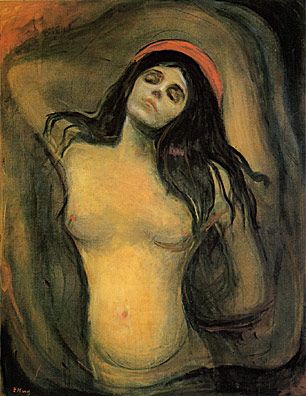A Mystery of a Woman

Puberty (1984)
In one of his most famous paintings “Puberty”a naked adolescent girl sits on the edge of the bed staring nervously and fixedly at the viewer. Her arms are crossed in front of her getinal area, as if to protect and block it from view, but in reality she is calling attention to the image’s central theme: emerging female sexuality. The bed and especially the large, insistently phallic shadow she casts on the wall to her left reinforce the painting’s primary message.
.
 The Woman in Three Stages (1894)
The Woman in Three Stages (1894)
The differing aspects of the female psyche are clearly expressed in his painting Woman in Three Stages (c. 1894), which can be seen as an important point of origin for The Dance of Life. The similarities between the two paintings are obvious. In Woman in Three Stages Munch also displays three women of different ages. A virgin figure with her "innocent phantasies of adolescent" gazes out to the sea. In the middle stands a physical mature woman, naked with her legs spread, who looks directly at the viewer. Her "seductive and provocative gaze is of such irresistible attraction that it guarantees the eternity of the human race". On the right side is a darkly dressed woman, hardly visible, with a pale face that bears witness to death.

Madonna (1894-5)
"Madonna" is one of my favourite paintings by Munch. He himself wrote:
"The pause during which the entire world stopes in its path. Moonlight glides over your face filled with all the earth’s beauty and pain. Your lips, as crimson as a ripe fruit, are half open as if to express pain. A corpse's smile. Here life and death shake hands. The chain that links thousands of past generations to the thousands to come has been meshed."
This painting was also called "Loving Woman" by Munch. This indicates that the painting carries both, religious and erotic content. The red "halo" emphasizes the connection with the Madonna. But the figure is also characterized by her abandonment to the sublime moment of love. "Madonna" depicts a woman seductively posed, or perhaps engaged in the sexual act: her arms urpised, her hips shift to one side, and her eyes closed in expressive reverie. Her frontal position forces the participation of the viewer, maybe as a sexual partner. The beautiful woman in the picture is a saint and a whore at the same time- sharing her body with the love one.

Madonna (Litograph, 1895-1902)









